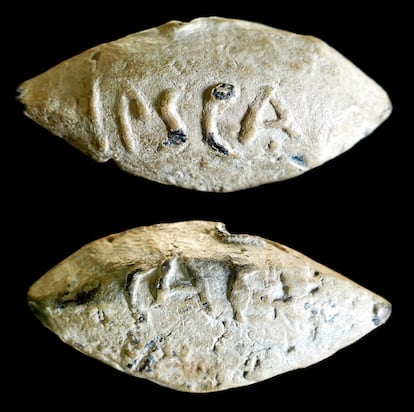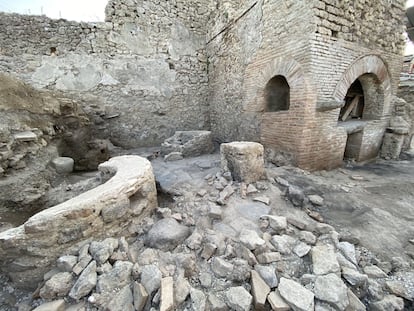The threatening message found on a Roman-era projectile
A piece of lead with the word ‘Caesar’ reveals that the feared Iberian slingers had allied with the Roman dictator to finish off his enemy


In 2019, a farmer in the province of Córdoba, Spain, found an almond-shaped lead projectile on his land. The object had two inscriptions, one on each side. Experts from the Autonomous University of Madrid, the Baena Historical Museum, and the Municipal Museum of Cabra, in Córdoba — Javier Moralejo Ordax, José Antonio Morena López, Antonio Moreno Rosa, and Jesús Robles Moreno — have now studied it. They have discovered that, thanks to the content of the inscriptions, it is a unicum, a term given to an archeological object that has no known equal. In fact, it is the first time that a lead projectile (glans in Latin) has been found with the name of Julius Caesar inscribed on it, and it is also the first that the name of the Iberian oppidum (fortified settlement at high altitude) Ipsca has been discovered in this type of specimen. The glans, which might have hit its target by virtue of the damage it presented, contained an implicit message: “The people of Ipsca are loyal to the cause of Julius Caesar against Pompey,” or perhaps: “Ipsca manufactured the projectiles of Caesar’s troops against Pompey’s.” At the time, Iberian slingers were feared for their deadly effectiveness.
The newly found glans has a length of 1.7 inches and weighs 2.51 ounces. It was made with a bivalve clay mold and is in good condition, although it has some dents. One of them could be due to its impact against a hard surface when it was used. The two inscriptions were made in the mold, so that, once the lead had solidified, they would remain in relief on the projectile’s body. These types of weapons were deadly due to the speed they could reach, which produced a “sudden and powerful impact that could often pierce a helmet and, if slung from a certain distance, could cause death.”
Considering its findspot, the inscriptions it has on it, the presence of other similar, but anepigraphal (without inscription), specimens in the surroundings, and analysis patterns such as its weight and formal features, archaeologists attributed the projectile to the campaigns conducted by Caesar and Pompey in Hispania. They were fighting for control of Rome between 48 and 45 B.C in the dying years of the Republic. This is the chronology proposed in the study En torno al bellum hispaniense y las glandes inscriptae de Hispania. Un nuevo proyectil con inscripción cesariana procedente de Montilla (On the Hispanic War and the inscribed glans from Hispania: A new projectile with Caesarean inscription from Montilla), published in the journal, Zephyrus.
On the so-called glandes inscriptae, or projectiles with inscription, the Romans used to engrave the name of the military units that manufactured and launched them (for example, Legio XIII) or the names of those in charge of some of the legionary units (M. Casius Scaeva). In other cases, reference was made to the cities or towns that participated in the battles, the most common being mentions of the great generals of the period such as Pompey the Great, Sertorius, and Octavian, who used these projectiles as support for propaganda messages in wars between Romans.
In the Iberian Peninsula, the most abundant are those that allude to Pompey and Sertorius. “His political intention was evident and the message was intended more for his own troops than for the enemy. The epigraphs on the projectiles were a very effective means of concisely materializing a political idea that could reach a large number of recipients and strengthen the bonds of cohesion between the troops and their generals,” state the authors of the study.
Montilla’s projectile therefore includes two messages: the name of the oppidum that was involved in the war campaign (Ipsca) and the name of the general they supported (Caesar). It is the first time that a glans has been found with the toponym Ipsca, which undoubtedly corresponds to a settlement that is well documented in literary and epigraphic sources, and which later became a municipium. “It is the first explicit mention of a city from this period in Hispania in the corpus of glandes inscriptae known to date. It should be added that, chronologically, it is the first epigraphic mention of the city that exists,” the study reads.
Projectiles with the inscription “Caesar” are well known on the Italian peninsula, but due to the type of inscription they have and the contexts of discovery, these specimens are dateable to between the years 41 and 40 B.C., and must be attributed to Gaius Caesar Octavian (later Emperor Augustus), who had taken the name of his adoptive father, Caesar, and enforced it among his troops in his confrontations with Mark Antony.
But in Jaén, southern Spain, a projectile with a double inscription was also found that in this case included two words: accipe and, perhaps, Cae(sar?), in the vocative case. Therefore, the Jaén and Montilla projectiles “are the only two in which an explicit epigraphic mention of Gaius Julius Caesar could appear, which is the only one to be called that in the context of the period of civil wars between Pompey and Caesar himself.”
“Suck it, Caesar”
However, the imperative accipe means in Latin “receive or take it,” which together with the vocative Caesar comes to mean “take it, Caesar”. “For the translation of the term we opted,” the specialists say, “for something more vulgar, which would be ‘suck it, Caesar.’ In our opinion, it better reflects the original spirit of the message.” This is a threatening projectile from Pompey’s troops, not Caesar’s.
On the other hand, the message on the glans found in Montilla is completely different. “It seems clear that the city of Ipsca and its inhabitants were deliberately aligned with Caesar and were careful to reflect this political alliance in the ammunition of their slinger corps. The two inscriptions very specifically express the link between Caesar and the Ibero-Roman city and suggest that a confrontation between Caesar’s troops and Pompey’s would have occurred in the area of Montilla, just 19 kilometers southwest of Ipsca itself.”
Ipsca is known both for the epigraphy, the toponymy that has been preserved and its location, next to the Izcar farmhouse in the municipality of Baena. There can be no doubt, “The inscription attests that the municipium of Ipsca Contributa was aligned with Caesar’s cause. In this way, the image of an urban center is outlined that, despite being surrounded by cities faithful to Pompey such as Ucubi, Ategua, and Torreparedones, remains faithful to Caesar.” They chose well. Caesar won the war.
Sign up for our weekly newsletter to get more English-language news coverage from EL PAÍS USA Edition
Tu suscripción se está usando en otro dispositivo
¿Quieres añadir otro usuario a tu suscripción?
Si continúas leyendo en este dispositivo, no se podrá leer en el otro.
FlechaTu suscripción se está usando en otro dispositivo y solo puedes acceder a EL PAÍS desde un dispositivo a la vez.
Si quieres compartir tu cuenta, cambia tu suscripción a la modalidad Premium, así podrás añadir otro usuario. Cada uno accederá con su propia cuenta de email, lo que os permitirá personalizar vuestra experiencia en EL PAÍS.
¿Tienes una suscripción de empresa? Accede aquí para contratar más cuentas.
En el caso de no saber quién está usando tu cuenta, te recomendamos cambiar tu contraseña aquí.
Si decides continuar compartiendo tu cuenta, este mensaje se mostrará en tu dispositivo y en el de la otra persona que está usando tu cuenta de forma indefinida, afectando a tu experiencia de lectura. Puedes consultar aquí los términos y condiciones de la suscripción digital.
More information
Archived In
Últimas noticias
Welcome to the post-religion era: The idea of Christianity as the absolute truth has become obsolete
‘I thought you would like it’: The risky sexual practice popularized by TV shows and TikTok
The digitalization of tourism: ‘They promise experiences and gave us the worst possible one’
Mexican peso defies uncertainty with forecasts of a new period of stability in 2026
Most viewed
- Sinaloa Cartel war is taking its toll on Los Chapitos
- Oona Chaplin: ‘I told James Cameron that I was living in a treehouse and starting a permaculture project with a friend’
- Reinhard Genzel, Nobel laureate in physics: ‘One-minute videos will never give you the truth’
- Why the price of coffee has skyrocketed: from Brazilian plantations to specialty coffee houses
- Silver prices are going crazy: This is what’s fueling the rally










































